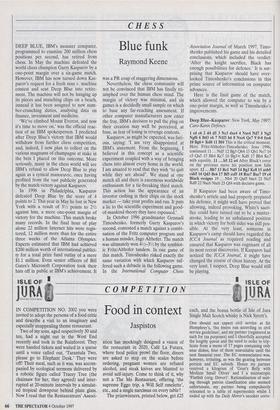CHESS
Blue funk
Raymond Keene
DEEP BLUE, IBM's monster computer, programmed to examine 200 million chess positions per second, has retired from chess. In May the machine defeated the world chess champion Garry Kasparov by a one-point margin over a six-game match. However, IBM has now turned down Kas- parov's request for a fresh man v. machine contest and sent Deep Blue into retire- ment. The machine will not be hanging up its pieces and munching chips on a beach, instead it has been assigned to new num- ber-crunching duties, analysing data on finance, investment and medicine.
'We've climbed Mount Everest, and now it's time to move on,' was the official reac- tion of an IBM spokesperson. I predicted after Deep Blue's victory that IBM would withdraw from further chess competition, and, indeed, I now plan to collect on the various magnums of champagne at stake in the bets I placed on this outcome. More seriously, many in the chess world will see IBM's refusal to allow Deep Blue to play again as a cynical manoeuvre, once having profited from the vast publicity generated by the match victory against Kasparov.
In 1996 in Philadelphia, Kasparov defeated Deep Blue by the score of 4 points to 2. This year in May he lost in New York with a result of 31/2 points to 21/2 against him, a mere one-point margin of victory for the machine. This match broke many records. In the final hour of play alone 22 million Internet hits were regis- tered, 12 million more than for the entire three weeks of the Atlanta Olympics. Experts estimated that IBM had achieved $200 million worth of international publici- ty for a total prize fund outlay of a mere $1.1 million. Even senior officers of Bill Gates's Microsoft Corporation took their hats off in public at IBM's achievement. It was a PR coup of staggering dimensions.
Nevertheless, the chess community will not be convinced that IBM has finally tri- umphed over the human chess mind. The margin of victory was minimal, and six games is a decidedly small sample on which to base any far-reaching assessment. If other computer manufacturers now enter the fray, IBM's decision to pull the plug on their creation may well be perceived, at base, as fear of losing in revenge contests.
Kasparov, as might be expected, was furi- ous, saying: 'I am very disappointed at IBM's statement. From the beginning, I believed in this concept as a scientific experiment coupled with a way of bringing chess into almost every home in the world. I am amazed to read that they wish "to quit while they are ahead". We stand at one match all and there is enormous worldwide enthusiasm for a tie-breaking third match. This action has the appearance of an investor cashing in their chips on the stock market — take your profits and run. It puts a lie to the scientific experiment and good- of-mankind theory they have espoused.'
In October 1996 grandmaster Gennadi Tirnoshenko, formerly Garry Kasparov's second, contested a match against a combi- nation of the Fritz computer program and a human minder, Ingo Althofer. The match was ultimately won 4'/2-3'/2 by the symbiot- ic Fritz/Althofer tandem. In one game of this match, Timoshenko risked exactly the same variation with which Kasparov suf- fered such a debacle in the following game. In the International Computer Chess Association Journal of March 1997, Timo- shenko published his game and his detailed conclusions, which included the verdict: 'After the knight sacrifice, Black has enough possibilities for defence.' It is sur- prising that Kasparov should have over- looked Timoshenko's conclusions in this prime source of information on computer advances.
Here is the final game of the match, which allowed the computer to win by a one-point margin, as well as Timoshenko's improvements.
Deep Blue–Kasparov: New York, May 1997; Caro-Kann Defence.
1 e4 c6 2 d4 d5 3 Nc3 dxe4 4 Nxe4 Nd7 5 Ng5 Ngf6 6 Bd3 e6 7 N1f3 h6 8 Nxe6 Qe7 9 0-0 fxe6 10 Bg6+ Kd8 11 Bf4 This is the critical moment. Here Fritz/Althofer—Timoshenko, .Tena 1996, continued 11 ... Nd5 12 Bg3 Qb4 13 QM Ne7 14 c3 Qa5 15 Bh4 Kc7 16 Bg3+ Kd8 17 Bh4 Kc7 with equality. 11 ...b5 12 a4 After Black's error on the previous move his position now falls apart. 12 ... Bb7 13 Rd l Nd5 14 Bg3 Kc8 15 axb5 cxb5 16 Qd3 Bc6 17 Bf5 exf5 18 Rxe7 Bxe7 19 c4 Black resigns 19 ...Nb4 20 Qxf5 bxc4 21 Ne5 Rd8 22 Nxc6 Nxc6 23 Qf4 with decisive gains.
If Kasparov had been aware of Timo- shenko's article and had properly prepared his defence, it might well have proved that allowing, indeed provoking, White's sacri- fice could have turned out to be a master- stroke, leading to an unbalanced position in which victory for both sides was still pos- sible. At the very least, someone in Kasparov's camp should have regarded the ICCA Journal as required reading and ensured that Kasparov was cognisant of all its most recent discoveries. If Kasparov had noticed the ICCA Journal, it might have changed the course of chess history. At the very least, I suspect, Deep Blue would still be playing.










































































 Previous page
Previous page